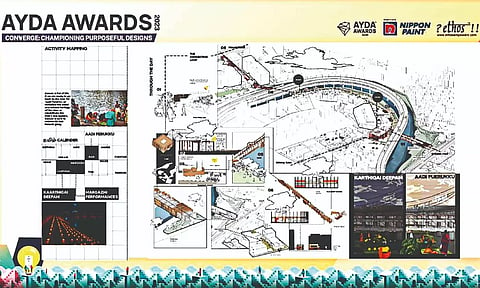

CHENNAI: Chennai native Eromitha Ramesh, currently studying at RV College of Architecture in Bengaluru, won the Gold Medal for her project, The Cooum Conundrum, at the Nippon Paint India’s AYDA Awards. The theme of this year’s competition urged young designers to integrate their design passions with impactful causes.
The Cooum Conundrum project aims to revitalise the significance of the Cooum River by transforming it into a vibrant ‘Realms of Reconnection.’ “This project delves into understanding our approach to building along river edges and ecologically sensitive areas. In the context of Chennai, there’s a tendency to encroach upon river edges for development. The project explores alternate ways of building and emphasises the importance of coexisting with other species along the riverbanks. By embracing the river edges as natural ecological zones and learning to share space with other species, we can redefine our approach to construction along these areas,” says Eromitha.
Historically revered as the city’s lifeblood, the Cooum River has suffered from pollution and neglect, leading to a disconnect between the people and their rivers. “I had never really understood the cultural significance of the River Cooum until I embarked on this thesis. During my research, I discovered the cultural mapping of the Cooum conducted by historian Venkatesh Ramakrishnan, as well as various articles and blogs, such as Madras Musings, which highlighted its importance. The journey of Madras to Chennai has been deeply intertwined with the Cooum River’s significance. Watching videos and hearing people discuss the river made me ponder why and how this transition occurred. Something that was once so revered and valuable to the city has now been reduced to sewage. Our perception of rivers strongly influences how we manage them,” explains Eromitha about the genesis of her project.
According to the architecture student, our treatment of rivers reflects their significance to us. “As an architect, I aimed to propose a different approach to development along the riverbanks. My project seeks to reconnect Chennai’s residents with the Cooum River by reshaping its banks into a new culturescape. It’s about bridging the divide between the city and its river, fostering a sense of responsibility. Inspired by Urban Wild Ecology, my design integrates architecture and landscape to create a balanced urban ecosystem. Through adaptable spaces and strategic interventions, I aim to harmonise human-made structures with nature, preserving the city’s heritage and natural beauty.”
During the project development process, Eromitha researched the Cooum restoration efforts aimed at reviving the river on multiple fronts. “While my project doesn’t encompass the complete cleaning of such a large river, it can serve as a small but impactful intervention. Alongside river cleaning, we must also address private spaces and educational institutions around it. We have numerous stakeholders to consider, and working with them along the river’s edge requires sensitivity,” concludes the student.